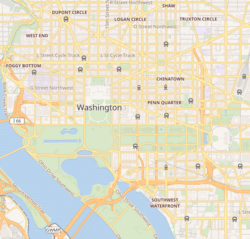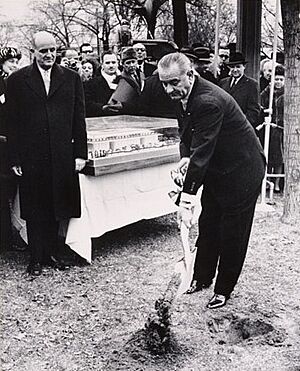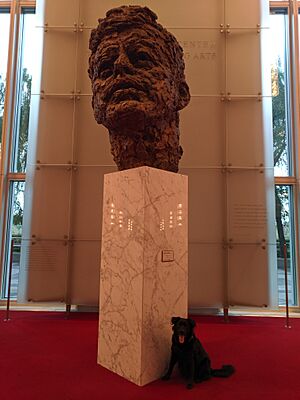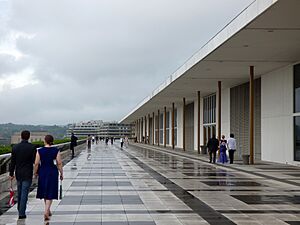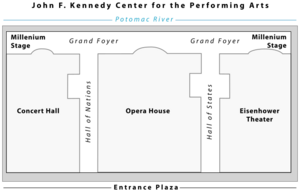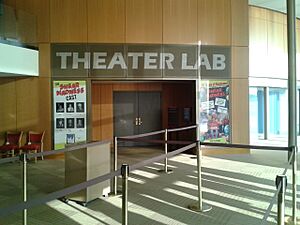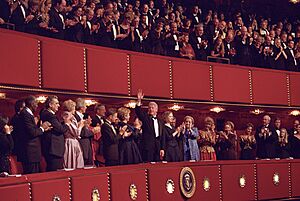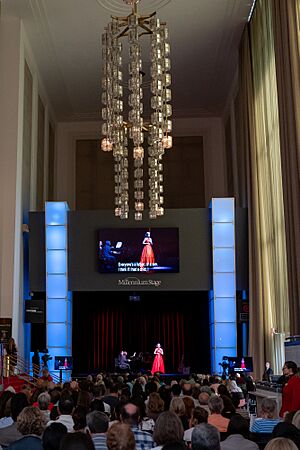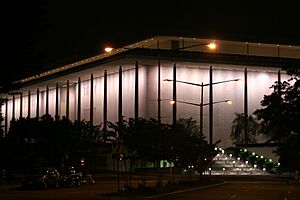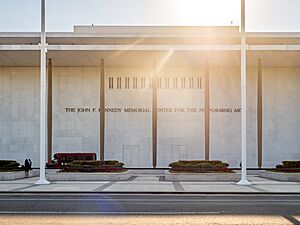John F. Kennedy Center for the Performing Arts facts for kids
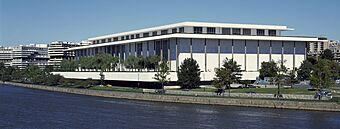
Kennedy Center seen from the Potomac River
|
|
| Address | 2700 F Street, NW |
|---|---|
| Location | Washington, D.C., United States |
| Coordinates | 38°53′45″N 77°03′21″W / 38.8957°N 77.0559°W |
| Public transit | |
| Owner | United States government |
| Operator | John F. Kennedy Center for the Performing Arts
|
| Type | Performing arts center |
| Capacity | Concert Hall: 2,465 Eisenhower Theater: 1,161 Family Theater: 320 Jazz Club: 160 Millennium Stage: 235 Opera House: 2,347 Terrace Theater: 490 Theater Lab: 398 |
| Construction | |
| Broke ground | December 2, 1964 |
| Opened | September 8, 1971 |
| Architect | Edward Durell Stone |
| Structural engineer | Severud Associates |
| General contractor | John McShain |
| Tenants | |
| National Symphony Orchestra Washington National Opera |
|
The John F. Kennedy Memorial Center for the Performing Arts, usually called the Kennedy Center, is the national cultural center of the United States. It is located on the eastern bank of the Potomac River in Washington, D.C. The center opened on September 8, 1971.
It hosts many different types of performances. These include theater, dance, classical music, jazz, and folk music. The Kennedy Center is also the home of the National Symphony Orchestra and the Washington National Opera.
The idea for the center began with a law in 1958. This law said that its programs should be supported by private donations. So, the center is a mix of public and private support. Its activities, like educational programs, are mostly paid for by ticket sales and gifts. The government provides money each year for the building's upkeep and daily operations.
The main building was designed by architect Edward Durell Stone. It was built by John McShain. The center is managed by the Smithsonian Institution. A newer part, called the REACH, was designed by Steven Holl and opened in 2019.
Contents
- History of the Kennedy Center
- Building Design
- Performance Spaces
- Performances and Programs
- Millennium Stage Archives
- VSA Organization
- Management and Funding
- See also
History of the Kennedy Center
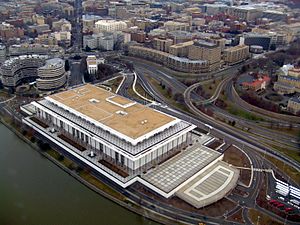
The idea for a national cultural center started way back in 1933. First Lady Eleanor Roosevelt thought it could help unemployed actors during the Great Depression. In 1935, Congress discussed building a large arts center on Capitol Hill. A resolution in 1938 called for a "National Cultural Center." But nothing was built at that time.
The idea came up again in 1950. A bill was introduced to fund a cultural center. This bill also said the center could not discriminate against performers or audience members. In 1958, President Dwight D. Eisenhower signed the National Cultural Center Act into law. This law officially started the project.
This was the first time the U.S. government helped pay for a performing arts building. Edward Durell Stone was chosen as the architect in 1959. His designs were well-liked, even though the estimated cost grew to $61 million.
In 1964, after President Kennedy's death, the center was renamed in his honor.
How the Center Was Funded
President Eisenhower created the National Cultural Center Board of Trustees in 1959. This group was in charge of raising money. At first, fundraising was slow.
President John F. Kennedy was very interested in bringing culture to Washington, D.C. He supported the project strongly. In 1961, he asked Roger L. Stevens to lead the Board of Trustees. Stevens then asked First Lady Jacqueline Kennedy to be an honorary chairman.
The total cost to build the center was $70 million. Congress provided $43 million. This included a $23 million grant and $20 million in bonds. Many donations also helped. The Ford Foundation gave $5 million, and the Kennedy family gave about $500,000. Other big donors included J. Willard Marriott and John D. Rockefeller III. Even other countries helped. Italy gave 3,700 tons of Carrara marble, worth $1.5 million, for the building.
Building the Kennedy Center
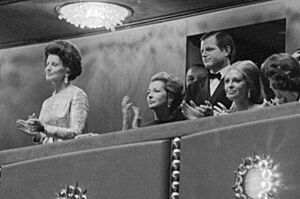
President Lyndon B. Johnson officially broke ground for the Kennedy Center on December 2, 1964. Construction began in December 1965. The site was ready by January 1967.
The first performance was on September 5, 1971. It was a preview of Leonard Bernstein's Mass in the Opera House. The official opening was on September 8, 1971, with a special gala and the premiere of the same work. The Concert Hall opened on September 9, 1971, with the National Symphony Orchestra. The Eisenhower Theater opened on October 18, 1971.
Updates and New Additions
In 1971, Congress started providing money for the center's daily operations and maintenance. Over the years, the Kennedy Center became fully responsible for its own building projects. From 1995 to 2005, over $200 million in federal funds were used for major repairs and safety updates. These improvements included fixing the Concert Hall and Opera House.
Recent Changes (2013-Present)

Starting in 2013, the center began a big expansion project. This added 60,000-square-foot (5,600 m2) of new space. The expansion, called the REACH, includes classrooms, rehearsal rooms, and performance areas. It also has three new buildings, a reflecting pool, and a tree grove. Steven Holl was the architect for this project.
The project cost about $175 million. It opened on September 7, 2019, with an arts festival. The REACH has won several design awards since it opened.
Building Design
Architect Edward Durell Stone designed the main Kennedy Center building. It is 100 feet (30 m) high, 630 feet (190 m) long, and 300 feet (91 m) wide. The building has a very long Grand Foyer, 630-foot-long (190 m) and 63-foot-high (19 m). It features 16 beautiful crystal chandeliers, which were a gift from Sweden.
The building has been praised for its great sound quality (acoustics). It also has a lovely terrace overlooking the Potomac River. To block out noise from airplanes flying nearby, the Kennedy Center was built like a "box within a box." This means each auditorium has an extra outer shell to keep it quiet.
The newer REACH extension, designed by Steven Holl Architects, opened in 2019.
Artworks at the Center
At the main entrance, there are two large artworks by German sculptor Jürgen Weber. These were a gift from West Germany. One is called War or Peace, showing scenes of conflict and harmony. The other is America, which shows Weber's view of the United States.
Another sculpture, Don Quixote by Aurelio Teno, is also on display. It was a gift from the King and Queen of Spain in 1976.
Performance Spaces
The Kennedy Center has three main theaters: the Concert Hall, the Opera House, and the Eisenhower Theater.
Concert Hall
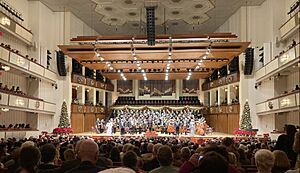
The Concert Hall is at the south end of the center. It can seat 2,465 people. It is the largest performance space and is home to the National Symphony Orchestra. It was updated in 1997 with new sound features and better access for people with disabilities. A new pipe organ was added in 2012.
Opera House
The Opera House is in the middle of the center and has about 2,347 seats. It has red velvet walls and a special red and gold silk curtain, a gift from Japan. It also has beautiful crystal chandeliers from Austria. This is where major operas, ballets, and large musicals are performed. It is the home of the Washington National Opera and hosts the yearly Kennedy Center Honors.
Eisenhower Theater
The Eisenhower Theater is on the north side and seats about 1,161 people. It is named after President Dwight D. Eisenhower. This theater mainly hosts plays, musicals, and smaller ballets. It was renovated in 2008.
Other Performance Areas
The Kennedy Center has several other performance and event spaces:
- Justice Forum is a lecture hall at The REACH for films and presentations.
- Millennium Stage offers free performances daily at 6:00 pm. These shows are also streamed online and archived.
- River Pavilion is a flexible space at The REACH with great views of the Potomac River.
- Room PT-109 is a meeting space at The REACH overlooking the reflecting pool.
- Skylight Pavilion at The REACH has a vaulted ceiling and glass skylights.
- Studio F and Studio J are multipurpose rehearsal rooms at The REACH.
- Studio K is the largest multipurpose room at The REACH and hosts the Kennedy Center Jazz Club.
- The Family Theater, with 320 seats, opened in 2005. It is designed for young audiences.
- The Terrace Theater, with 490 seats, was a gift from Japan. It is used for chamber music, ballet, and theater.
- The Theater Lab, with 399 seats, has hosted the play Shear Madness since 1987.
Rooftop Terraces
The Kennedy Center has open-air rooftop terraces that are free for the public to visit. They offer amazing views of Washington, D.C., including the Potomac River, the Lincoln Memorial, and the Watergate complex.
Performances and Programs
Dance Performances
The Kennedy Center often commissions new ballet and dance works. These are created by famous choreographers for top American dance companies. The center also supports two yearly dance programs for young people. These are "Exploring Ballet with Suzanne Farrell" and the "Dance Theatre of Harlem Residency Program."
The center's Contemporary Dance series features many different dance styles. It has showcased both famous masters and exciting new artists. The center is also known for its yearly production of The Nutcracker ballet.
Learning Through Arts
The Kennedy Center has expanded its public education programs across the country. The Family Theater, opened in 2005, helps with this goal.
Theater for Young Audiences
The "Theater for Young Audiences" program offers many performances for young people and schools. It has premiered new musicals and plays. Some of these shows have even gone on national tours.
National Symphony Orchestra for Young Audiences
Members of the National Symphony Orchestra (NSO) present "Teddy Bear Concerts" for young children. Kids can bring their favorite stuffed animals to these interactive music programs. The NSO also connects music with school subjects like science and math.
Kennedy Center American College Theater Festival
The Kennedy Center American College Theater Festival (KCACTF) started in 1969. It is a national theater program for college and university students. It helps improve college theater across the U.S. Over 17.5 million students and teachers have been part of this program.
Changing Education Through the Arts (CETA)
The CETA program aims to make arts a key part of every child's education. It provides training for teachers and school leaders. Teachers learn how to include arts in their lessons. CETA also works with schools in the Washington D.C. area to develop long-term plans for arts integration.
Exploring Ballet with Suzanne Farrell
"Exploring Ballet with Suzanne Farrell" is a three-week summer ballet program. It is for pre-professional ballerinas aged 14–18 from around the world. Suzanne Farrell, a famous ballerina, has hosted this program since 1993. Students practice technique and choreography daily. They also go on trips to explore Washington, D.C.
Art and Ideals: President John F. Kennedy
Opened in September 2022, this is a permanent exhibit. It focuses on President John F. Kennedy's connection to art. The exhibit shows how art played a role in culture, democracy, and social change during his time.
Festivals
The Kennedy Center hosts festivals that celebrate cultures from around the world. These festivals feature performing arts, visual arts, and food. Past festivals have explored the cultures of Japan, Arab countries, and India.
Jazz Music
The Kennedy Center has featured jazz music since it opened in 1971. In 1994, Dr. Billy Taylor became the Artistic Advisor for Jazz. The center has many programs to promote jazz. These include the "Mary Lou Williams Women in Jazz Festival" and the "KC Jazz Club."
The center also has educational programs for jazz. These include workshops and programs for young jazz talent. Famous artists like Lady Gaga and Tony Bennett have performed jazz here.
National Symphony Orchestra (NSO)
The National Symphony Orchestra has been connected with the Kennedy Center since 1987. It has ordered many new musical works from composers. The NSO also performs concerts for families and at Wolf Trap.
The NSO has a special program called "American Residencies." Each year, the Orchestra visits a different state. They perform concerts and teach music classes there.
Performing Arts for Everyone (PAFE)
The Kennedy Center is unique because it offers a free performance every day of the year at 6 pm. This is called the Millennium Stage. It features many different art forms, from dance and jazz to comedy and storytelling. Over three million people have attended these free shows.
Since 1999, the center has streamed these performances live online. They also keep an archive of over 3,000 past shows on their website. The PAFE program also offers low-cost and free tickets to other performances.
The Conservatory Project
This event happens twice a year. It showcases talented young musicians from top music schools. They perform classical, jazz, musical theater, and opera.
Artist Residencies
The Kennedy Center hosts artists who work with the center's groups and programs. They have artists-in-residence for composing, education, and culture. Current artists include The Roots and author Jacqueline Woodson.
Theater Productions
The center has helped create over 300 new theater works. Many of these have won awards. Some famous shows include Annie, A Few Good Men, and Les Misérables. The center also produced a special series of six Stephen Sondheim musicals in 2002.
Kennedy Center Honors
Since 1978, the Kennedy Center has given out the Kennedy Center Honors every year. Five artists or groups are recognized for their lifelong contributions to American culture and performing arts. This includes dance, music, theater, opera, film, and television.
Mark Twain Prize for American Humor
The Kennedy Center has given the Mark Twain Prize for American Humor every year since 1998. It is named after the famous humorist Mark Twain. The prize goes to people who have made a big impact on American society through humor.
Local Arts Groups
Many local arts groups perform at the Kennedy Center. These include:
- American Film Institute
- The Washington Chorus
- The Cathedral Choral Society of Washington
- Choral Arts Society of Washington
- Opera Lafayette
- VSA arts
- The Washington Ballet
- Washington Concert Opera
- Washington National Opera
- Washington Performing Arts Society
- Woolly Mammoth Theatre Company
- Young Concert Artists of Washington
Other Events
The Kennedy Center often hosts special events for presidential inaugurations and galas. In 1976, for the United States Bicentennial, the center held many special events. This included free performances from groups representing every state.
Millennium Stage Archives
The Kennedy Center's Millennium Stage in the Grand Foyer hosts free daily performances. These shows feature a wide range of artists and groups.
All free events on this stage are recorded. They are then archived on the Kennedy Center's website. These archives have been available to the public for free since 2009.
VSA Organization
VSA (formerly VSA arts) is a non-profit organization started in 1974. Its goal is to help people with disabilities learn about and enjoy the arts. VSA provides resources for teachers, parents, and artists. It also highlights the achievements of artists with disabilities.
Each year, 7 million people take part in VSA programs. These programs are offered through a network across the U.S. and in 54 other countries. VSA officially became part of the Kennedy Center in 2011.
Management and Funding
Before 1980, the chairman of the board oversaw the daily operations. In 1991, the role of president was created to manage daily tasks. Michael Kaiser became president in 2001. In September 2014, Deborah Rutter became the third president and the first woman to hold that job.
In February 2025, Rutter was dismissed as president. This happened shortly after U.S. President Donald Trump became chairman of the organization. Richard Grenell was named interim executive director.
Funding and How it Works
The Kennedy Center is a mix of public and private funding. Its programs are mostly paid for by ticket sales and donations. The U.S. government provides money each year for the building's maintenance and operations.
Board of Trustees
The center's board, called the Trustees of the John F. Kennedy Center for the Performing Arts, manages the center. The First Lady of the United States and past First Ladies are honorary chairs. The board also includes government officials and 36 trustees appointed by the President.
Recent Changes (2025)
In February 2025, President Trump named Richard Grenell as interim executive director. Trump had criticized some of the center's programming. He dismissed previous board members and appointed new ones. These new members then elected him as chairman.
The center soon canceled the national tour of a children's musical called Finn. A spokesperson said it was a "purely financial decision." However, some people saw this as an attack on free speech. Several celebrities and artists then decided not to work with the Kennedy Center.
In May 2025, Washington Performing Arts announced it would move its 2025-2026 season concerts to other venues. In July, U.S. House Republicans suggested renaming the Kennedy Center Opera House to the Melania Trump Opera House. This change still needs approval.
See also
 In Spanish: Centro John F. Kennedy para las Artes Escénicas para niños
In Spanish: Centro John F. Kennedy para las Artes Escénicas para niños
- Architecture of Washington, D.C.
- List of memorials to John F. Kennedy
- List of theaters in Washington, D.C.


